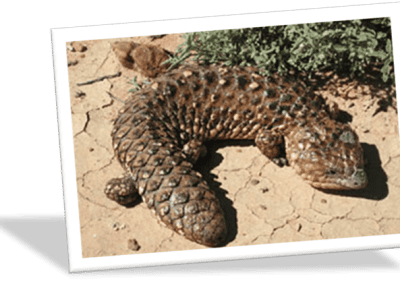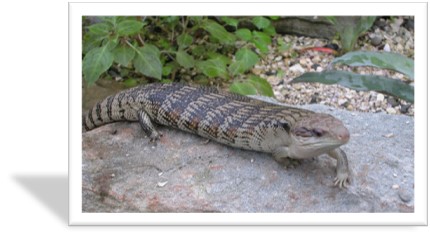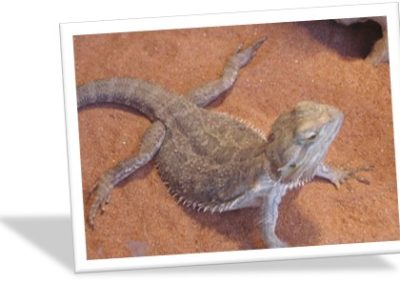facts and care advice
Lizards
includes Blue Tongue, Shinglebacks and Bearded Dragons
If you find an injured lizard call a carer or bring it to the vets.
Lizards are very clever escape artists. For transportation purposes, the lizard can be placed in a cotton bag or pillowcase (inside out, so that the lizard does not get caught on any loose threads) that is securely tied. Then the pillowcase/cotton bag can be placed in a box with air holes. If a box is available.
Place the lizard in a warm, quiet, dark room.
If you are rescuing be sure it is a lizard. Call Fauna Rescue on 08 8289 0896.
- Lizards can bite! Hard! Handle carefully, the easiest way to pick up a lizard is to place a towel over the animal, noting where the head and back legs are, and scoop them up with your hands along the length of their body. Make sure there is a suitable container close by to put them in. A shoe box or a bucket they cannot climb out of is fine.
- Check for obvious injuries, i.e. obvious blood, severed limbs or part of the tail missing. In these cases the lizard should be taken directly to a vet. Ticks must be removed completely including the head. There should be no charge when surrendering a native animal to a vet clinic for care or euthanasia.
- If it is an animal attack, (cat or dog bite), need antibiotics. Minor wounds can be bathed with saline and treated with an antibiotic cream or a dilute solution of 1:10 betadine solution.
- Quiet and dark is needed for the lizard to recoup from the stress of being rescued and treated. Be sure it is contained and cannot get out of the enclosure.
- A bowl of water, heat and a place to hide is required in the enclosure.
- Release site: It is preferable to release lizards back to the general location at least within a few kilometres of the point of origin.
- Lizards have specific dietary and heating requirements and also UV, if in care for more than a few days so for this reason it is best to contact Fauna Rescue of SA on 08 8289 0896.
Think of your safety first, and ensure that it is a lizard and not a snake. If unsure just observe it. Does the reptiles have ear openings (holes behind the eyes about level with the back of the head on the side). Does it have eyelids. Does it blink. If it does not it is a snake.
Is it flicking its tongue? If so, what is the shape of its tongue? If it is a FORKED tongue LEAVE IT ALONE it is not a lizard, it is a snake. If the tongue is plump and rounded it is a lizard.
In summary lizards have ear openings and eyelids and can blink: and legs (though some species are hard to see) and a rounded tongue. Snakes have no ear openings,no eyelids and no legs and a forked tongue.
The most common reptiles that come into care are Blue Tongue lizard, the Sleepy lizard (also called the Shingleback or Pinecone lizard), and the Bearded Dragon.
All lizards are ectothermic meaning they rely on external temperature sources for thermal regulation of their bodies in contrast to mammals which are endothermic and have internal thermal regulating mechanisms (i.e. sun/shade, rocks, etc…) to control their body temperature.
Lizards need to be warm before being fed, otherwise the food will decay in their stomachs. They eat a variety of plants, insects and small animals according to their species.
When frightened, they either freeze fight or flight, or suddenly disturbed, they try to escape by bluff, flight, hiding or biting.
Many lizards are usually diurnal (awake during the day) and ground-dwelling (stays on the ground). Although Bearded Dragons are semi-arboreal (sometimes climb trees).
Blue Tongue Lizards:
These lizards belong to the skink family, and happily live in the backyard or in the bush. They are a shy ground dwelling species spending much time hidden when not foraging for food or warming up in the direct sun. The scales of the Blue Tongue are smooth and has alternating dark and narrower lighter stripes across the body. Their tongue are wide, blue and fleshy hence the name ‘blue tongue.’The tail is shorter that the body length. They can grow to around 60cm (23 inches).
The Blue Tongue lizard has between 5 and 20 live young but more commonly around 5 to 10. The newborn are around 6-7.5 cm long. They are fully independent at birth. Although they can sometimes stay in the proximty of the mother for a short time they normally disperse to find there own way in life.
When they feel threatened, they inflate their lungs, causing their bodies to swell. They turn towards the threat with an open mouth, displaying a contrasting blue tongue and pink mouth. Then they exhale causing a hissing sound.
Blue Tongue skinks are omnivorous meaning there diet is varied and includes vegetable matter including dandelions, yellow milk thistle, chopped up vegetables and fruit mix and protein from animal sources including snails, insects (crickets, mealworms spiders). In captivity they enjoy egg (raw, scrambled or boiled), good quality tinned dog food. Mince meat of any kind is not recommended due to its high phosphorus content which can lead to calcium deficencies leading to bone growth problems including metabolic bone disease.
Sleepy Lizard:
This lizard is known by a couple of names, the most common ones being the Shingleback, the Stumpy Tail lizard and the Pinecone lizard. It has overlapping scales which resembles a closed pine cone. The head is almost a triangular shape and when it reaches maturity the tail is as large as the head. The colour can vary from light to dark brown, with patches of lighter colour especially down the sides. It has a wide blue fleshy tongue.
Their defence against predators is to open their mouths and hiss.
They give birth to 1-2 live young. The newborn are about 9 cm in length and are independent. These lizards are essentially an arid land reptile.
They are slow moving so they have a diet of slow moving insects and a variety of plants. In care they can be given snails, insects (mealworm), chopped up vegetables and fruit mix (no spinach), egg (raw, scrambled or boiled), mince (without preservatives) and good quality tinned dog food.
Bearded Dragon
This refers to two species commonly encountered. Firstly the Common Bearded Dragon Pogona Barbata which is endemic to the Adelaide Region and is predominantly a woodland species found in temperate regions with average rainfall. Secondly The Inland Bearded Dragon Pogona Vitticeps which has a natural range which is limited to around north of Port Augusta and is more of a desert species living in arid landscapes. Both are arboreal species.
The latter species has gained popularity in the pet trade over the last 30 years due to its generally likeable placid nature and adaptability to human interaction and captivity and hence has become increasingly common locally, whether due to escapes or as abandoned or surrended pets.
Both species get their names from their ability to “puff out” a throat pouch that has prominent spikes formed from modified scales. Both males and females have the beard.
When threatened the lizard will puff up the beard, open their mouth as a way of appearing larger to the approaching predator.
They are semi arboreal, spending a significant amount of time resting on tree branches and a are commonly seen on fence posts.
Bearded Dragons are egg layers depositing between 10 to 30 eggs which the female deposits in a burrow which is then covered over. Eggs take around 10 weeks to hatch into miniture adults. They are omnivorous feeding both on plant and animal matter in the wild. In captivity a diet consisting of insects and chopped vegetables and leafy greens is sufficient.
![]()



